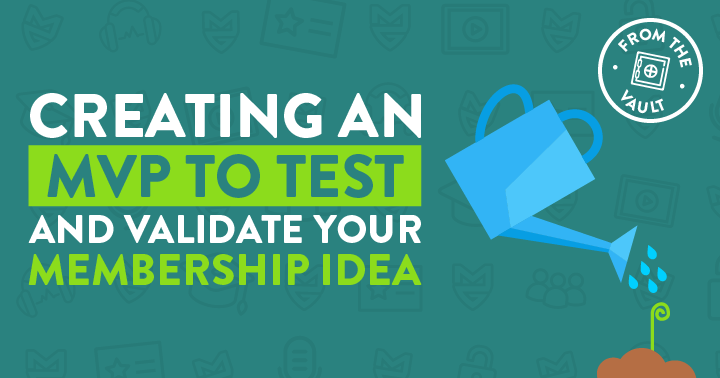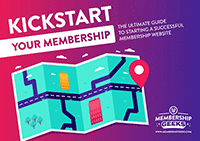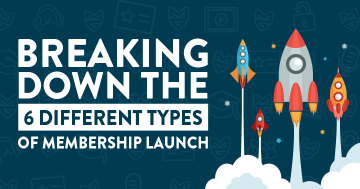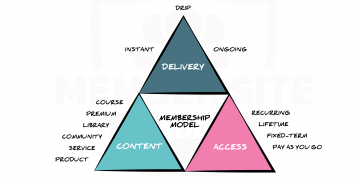Do you have an idea for a membership that you’re just not sure about?
When you come up with what you think is the world’s greatest membership idea, it’s easy to let the excitement blind you from the facts revealed in your research.
Or, maybe you’ve skipped doing any research or analysis entirely because you’re so confident that you’ve got a winning concept up your sleeve?
Unfortunately, this frame of mind is the culprit of many failed memberships.
If the concept and product aren’t right, nobody is going to sign-up to join and you risk wasting a lot of time and money.
Before you pursue your membership idea, you need to test and validate it with an minimum viable product – an MVP.
This will help you to discover whether your idea has true potential, without a significant investment up front, or if you should go back to the drawing board.
What is an MVP?
An MVP (minimum viable product) represents a stripped back version of your membership.
It includes the bare minimum and you can offer it to your market as a test to see how it’s received and to collect important feedback for future product development.
It’s the bare minimum version of your membership. It’s not very comprehensive, but it is enough to validate your idea and see whether or not people will want to buy it.
Your MVP will also validate your market-to-solution alignment, in other words it’ll help to confirm that what you’re offering is something that your audience actually wants.
Plus, it’s a great way to validate your ability to compel people to action.
Even if your idea is something that your audience can’t wait to get a hold of, it could all be for nothing if you can’t effectively sell it to them.
An MVP confirms that a buying market exists for your membership.
No matter how amazing your membership is, some people will never pay for it, which is why you need to make sure your audience is willing to invest in your membership before going ‘all in.’
One of the main benefits of an MVP is the feedback you’ll get from paying customers.
It’s this feedback that will ultimately help you refine your final membership product.
Having a good idea of how your audience will respond to your membership idea gives you the opportunity to foresee the potential of your site without having to go through all of the work and content creation.
What makes a good MVP?
Successful MVP’s tend to share similar characteristics. The most important of which is a membership’s ability to solve a problem or deliver an outcome that addresses the same pain points that you intend your actual membership to address.
If it doesn’t, you won’t receive a strong enough indicator that your membership will be of interest to your audience.
Another thing to keep in mind about your MVP is that it shouldn’t take a lot of time to create.
This defeats the point.
You don’t want to spend an unnecessary amount of time planning and creating it only to find that nobody actually wants to buy it.
That’s not to say you shouldn’t make it great. You absolutely should, but it should only involve minimal upfront work on your part.
Now, a question I get asked a lot about MVP’s is how much you should charge.
Pinning down the right price is important, and I suggest charging a figure similar to what you intend to charge for the final product.
Members can either make a single one-off payment (usually the equivalent to your monthly fee for your membership) or an annual payment if you believe your MVP has the same customer lifetime value as that of your membership.
Whether or not people are willing to pay for your MVP validates your idea because if nobody wants to pay for the MVP, they probably don’t want to pay for the actual membership either.
Most people don’t consider an MVP to be viable unless payment is received.
It’s that age-old saying “put your money where your mouth is”, because people may tell you it’s a great idea and they would join, but we don’t want woulda, coulda, shoulda…we want action!
If you’re unable to create an MVP that people will pay for, there are other things you can do to secure commitment. T
hings like pre-orders, signing up for a waiting list and so on are great indicators of a viable membership idea.
Now that you know more about what makes a good MVP, you need to decide what type of MVP you’re going to create for your membership.
There are six types of MVP’s to choose from:
1. Interest Gauge
The interest gauge is an MVP that’s created solely to capture people’s interest in your membership idea.
The best-case scenario is that you convince someone to make a form of commitment. This commitment acts as proof that they would join your membership if it was a viable option for them.
But how can you create an interest gauge and what does it entail?
The first thing you should do is start a waitlist.
Keep it simple and don’t ask people for too much.
Their name and email address is more than enough and when they give that to you, it’s a clear sign that they’re interested in your membership because they want to be right at the forefront when your membership opens.
Another great way to create an interest gauge MVP is to ask your audience to complete a survey. This is your chance to get specific with your questions. If there’s anything you want to ask your audience, this is your window of opportunity.
Questions such as, “Are you interested in joining this membership?” will give you direct responses, leaving no room for guessing or subjective interpretation.
Your audience could even give a simple yes or no answer, making it incredibly easier for you to determine the level of interest in your membership.
An interest gauge gives you a fairly good starting point.
You probably can’t see the finishing line yet, but you will be building an audience who are much more likely to commit because they’ve expressed an interest that was clarified the moment that they agreed to share their personal information with you.
2. Coaching
Coaching is a great MVP for membership sites because it helps you validate your idea and the level of interest it’ll receive from your market.
There are two different ways that you can offer coaching as an MVP:
Sell one-hour blocks of consultation time
This is where you offer a one-to-one virtual coaching session with a potential member who has a problem they need help solving.
I know what you’re thinking – your time is worth more than the cost of a single month of membership and I agree.
Your time is worth more than that.
However, you’re not doing this for profit.
You’re doing it because you have a membership idea that needs validating.
Offer a group coaching programme
This involves coaching a group of eight to 10 people.
You hit a few birds with one stone this way and you can even offer a monthly product to sweeten the deal.
Something like a bonus one-to-one call each month or quarter should suffice. While this approach is less structured, there’s a lot of value on the table it’s still centered around coaching.
Coaching MVP’s have a lot of benefits. Not only are you getting the validation your membership idea needs, but speaking directly to your audience opens you up to a host of new possibilities.
You’ll discover more about your audience and what they want to see from your membership, making it an excellent form of research.
On the other hand, a coaching MVP may set unrealistic standards in terms of how much one-to-one coaching members can expect to have with you. Someone might love your coaching MVP because of that continuous access to you and your expertise.
But, if your membership doesn’t offer the same level of personal coaching, it may be enough to sway someone away from joining your actual membership.
3. Basic Info Product
If you have a standalone course in mind for your membership, offering a basic info product MVP might be the one for you.
You can make things easier for yourself by repurposing an existing course or using one that you plan to include in your membership.
Selling your basic info product is a great way to validate the quality and demand for your content.
If your course is very in-depth with lots of resources, the price point should reflect this. If it’s a smaller or less intense course, you can probably charge the same amount as you would for a single month membership.
Offering a basic info product lets you see whether your audience are interested in your content. You should also consider the type of feedback you’ve had from your audience regarding the product.
Use this information to help refine your courses so when you’re working on creating the content for your membership, you’ll have a better indication of what your audience actually wants from you.
4. Training
If you want to offer a training MVP, you could do a physical workshop, a paid webinar or even a virtual training course.
Training MVP’s tend to be quite similar to the type of content you’ll offer inside your actual membership.
So, it’s a great way to find out whether or not your idea has what it takes to succeed.
After all, if people are willing to pay for your training MVP and they get tons of value from it, it’s a good indicator that they’ll want to pay for more.
But how much should you charge for your training MVP?
A good ballpark price is to charge the same price as one month’s payment of the membership. However, if your training course goes on for eight or so weeks and it includes live training sessions, you can up your price point to be the equivalent of your estimated lifetime value.
If you decide to create a training MVP, you’ll cut your future workload down a significant amount because you’re actively creating content as you’re in the process of validating your membership idea.
If your idea proves to be a success, you can then return to your training courses and repurpose that content for your actual membership site.
5. Presale
The presale MVP is designed to help you build your membership audience and take orders before your membership is released.
To do this effectively, you can take pre-orders.
Giving people the ability to make a payment towards their membership before you open the doors is a great way to establish the level of interest in your membership while securing future members in advance.
Another option is to use crowdfunding and pre-sell your membership on a platform such as Kickstarter. To entice interest, you should offer bonus content based on the level of commitment.
Keep in mind that there’s a very real possibility that you could receive an array of pre-orders only for you to later realize this isn’t the direction you want to take your membership.
So, before you go off and start spending like crazy, it’s worth transferring the money from the pre-orders into a separate account or put it in escrow.
That way, if you do decide to not continue with your membership idea, you can refund people’s money hassle-free.
6. Selling a Bare-Bones Membership Website
The final type of MVP for membership sites is to create and sell a bare-bones membership website.
Don’t worry, this isn’t going to be your final membership site. Instead, think of it as a lightweight version of your membership.
It’s a stripped-down version of the real thing, which means it only contains the bare essentials needed to justify its place in the market.
It’s also important to think about it in both long-term and short-term.
So, if it’s a long-term MVP, you can include workshops and lots of great content. Whereas a short-term MVP will include things like live member webinars, discounts, custom tools and any existing resources that you want to share with your members.
If you’re building a basic membership website for your MVP, remember to choose basic setups.
Avoid complicated plugins and stick to the bare minimum to help keep things as simple as possible.
If you want to go even more stripped-down than that, you can deliver premium content via email.
This involves giving people a way to pay in order to sign up to a special email list, and then sending them premium articles, videos, useful attachments and so on. When it comes to your community, you could use something like Slack or even a simple Facebook group to get up and running quickly.
The end result is that you have a membership product that you can sell, but it's “bootstrapped” in a way that saves a lot of upfront time and money until the time comes to realise your full vision for the site.
Remember that the purpose of your MVP isn’t only to test and validate your membership idea but to potentially bring members closer to actually joining your membership.
An MVP requires minimal set-up, saving you time and money and giving you invaluable insights into what people want from your membership.
Discover the best type of MVP for your membership idea from the six listed above and it won’t be long before you determine whether your membership idea is worth pursuing, or not.





